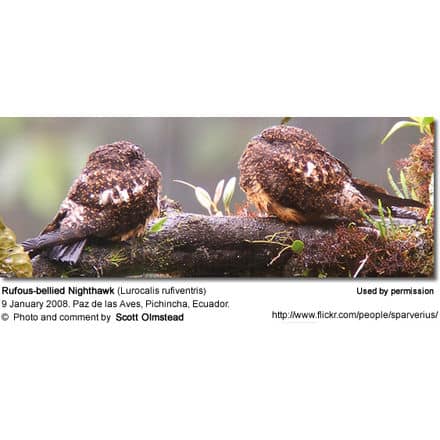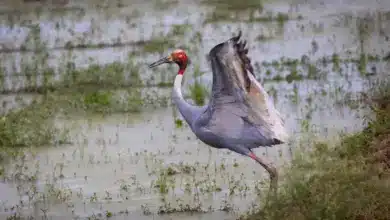Rufous-bellied Nighthawks
The Rufous-bellied Nighthawks (Lurocalis rufiventris formerly Lurocalis semitorquatus rufiventris) is also known as Taczanowski’s Nighthawk – honoring the person that described this species in 1884, namely W?adys?aw Taczanowski who was one of the most important European zoologists of the nineteenth century.
This South American nightjar was formerly considered conspecific (one and the same species) with the Short-tailed Nighthawk (Lurocalis semitorquatus) with which it probably forms a superspecies. (Superspecies are closely related species with non-overlapping distributions; they are thought to have evolved from the same species).
The nightjar, as suggested by the name, is strictly nocturnal. Throughout the day, it typically rests quietly in densely vegetated hiding places. At night, they become active as they hunt flying insects in more open landscapes, such as forest clearings, wetlands, and along rivers.
Thanks to their cryptic appearance, these birds blend perfectly into their habitat, making them very difficult to spot during the daytime, when they are usually hidden away from sleeping. They are most easily detected at night when light from car headlights is reflected red from their eyes, as they are sitting on tracks or roads. However, their presence is most often made known by their loud calls given at dusk.
Alternate (Global) Names
Chinese: ???? … Czech: lelek rezavob?ichý … Danish: Rødbuget Nathøg … German: Andennachtschwalbe, Rostbauch-Nachtschwalbe …Finnish: Andiensepelkehrääjä … French: Engoulevent à ventre roux, Engoulevent à verntre roux … Italian: Succiacapre panciarossiccia … Japanese: chabarayotaka … Norwegian: Rustbuknatthauk … Polish: lelczyk andyjski … Slovak: súmracník cervený … Spanish: Añapero Ventrirrufo, Chotacabra de Vientre Rufo, Chotacabras Buchirrufo … Swedish: Rödbukad falknattskärra

Distribution / Range
The Rufous-bellied Nighthawks occur naturally in the Andean cloud forests, from western Venezuela to south-western Colombia, south through central Ecuador, western and southern Peru to western Bolivia. It is resident (non-migratory) throughout its range.
They occur in several protected areas, such as Las Palmas Cloud Forest Reserve and Podocarpus National Park in Ecuador; the Megantoni National Sanctuary (Cusco, Peru), and Otishi National Park in Peru.
This species inhabits subtropical and tropical moist montane evergreen forests and has been observed flying over the canopy at dawn and dusk foraging for insects. In flight, its mournful call consisting of a descending series of notes can be heard.
This species is difficult to spot due to its nocturnal habits. Its brown-mottled plumage keeps it well camouflaged during the day when it is also usually hidden away from sleeping.
Description
The Rufous-bellied Nighthawks is a large, dark nightjar with long wings, a short tail, and a very short bill.
Their soft plumage is cryptically colored to resemble bark or leaves. The throat is white and the wings and tail are all dark. The belly is a yellowish-brown color, They have short legs and small feet, of little use for walking.
Nesting / Breeding
The male establishes his territory and sings at night to keep rivals away and at the same time to attract a female.
Rufous-bellied Nighthawks don’t actually construct a nest, as most other bird species do. They simply place the eggs on the ground on open soil covered with dead leaves.
Nesting appears to be timed in such a way that the moon is more than half full at the time they are feeding their young – likely as the additional light during the night facilitates caring for the young and foraging for food.
The female may lay one to two eggs (mostly two) that are whitish or creamy in color, with brown and grey spots or blotches.
During the day, the incubation of the eggs is undertaken by the female, while both parents share the incubation at night. The incubation period is about 19 to 21 days.
The hatchlings emergee covered in down. Within 24 hours of hatching, they are capable of short-distance movements. The male usually stands guard and defends the nest and the young. He will hover in place near the nest with his body in a nearly vertical position. The adults communicate with their chicks via soft clucking sounds to which the chicks respond.
The chicks are fed regurgitated insects by their parents, who will continue to brood them until fledging. The young take their first flight when they are about 20 to 21 days old.
If conditions are favorable, the female may lay a second clutch close to the first and while she is incubating the new set of eggs, the male continues to care for the young from the first brood.
They have developed several behavioral adaptations to minimize predation:
- Their nocturnal (night) lifestyle reduces the likelihood of being detected by daytime predators. During the daytime, they typically sleep on the ground where they are perfectly camouflaged by their “earthy” colored plumage. They almost always change their roost sites on a daily basis.
- When nesting, they sit quietly on the eggs, minimizing any movements that could get them detected.
- If an intruder does get close to the nest, the parents may try to lead them away by first flushing off the nest and when landing feigning injury as they lead the potential thread away from the nest. While the parent performs this distraction display, the young may scatter and freeze.
- The parent who is not incubating the eggs or brooding the young will roost away from the nesting area.
- They may also move the eggs or young to prevent them from being preyed upon.
- Nightjars avoid voicing when they hear the calls made by predatory nocturnal animals, such as owls.
The Feeding Habits of Nightjars / Nighthawks



